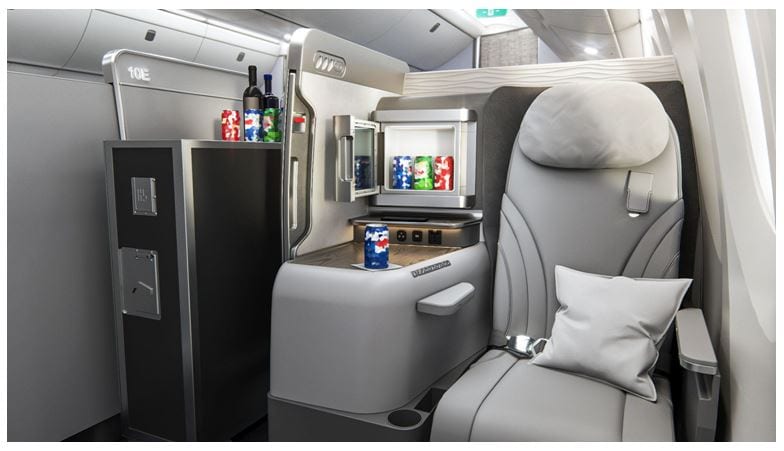Aircraft cabins have a very strong need for cooling and especially in galleys, cooling is required to store all the food and beverages. Typically refrigerant based heat exchanger consisting of condenser evaporator compressors is employed to achieve the desired cooling.
Although their performance is acceptable they consume a lot of space, the units are not modular and the use of refrigerants impact on global warming. Cooling requirements in interiors system demand a more modular low profile space efficient systems which can be integrated into multiple applications like galleys, Seats etc.
Typical Refrigerant Based heat exchangers
Discussion on topic
In order to achieve a space efficient modular cooling solution Collins Aerospace has introduced SpaceChiller™, a modular thermoelectric cooling system scalable to fit a variety of applications throughout an aircraft’s interior. Introduced at the Aircraft Interiors Exposition in Hamburg, Germany, SpaceChiller quietly and efficiently chills compartments to food-safe temperatures without the use of refrigerants that may impact global warming.
With applications ranging from premium suites and passenger social zones to single galley inserts and whole cart bays, airlines benefit from flexibility in service, storage and space without sacrificing room for passengers and flight attendants.
SpaceChiller uses advanced heat sinks, initially developed for The Defense Advanced Research Project Agency (DARPA), that reduce power consumption up to 50% over alternate thermoelectric systems and can be leveraged across multiple service areas and passenger seats.
Collins Aerospace’s SpaceChiller™ has been named a winner of a Crystal Cabin Award. A jury of 27 aviation industry experts announced the winners across eight categories June 14 in Hamburg, Germany.
SpaceChiller images from the Hamburg expo
The important factor governing the over all size of the heat exchanger unit is the fin gap. Minimum fin gap is essential to achieve higher heat transfer performance per unit size. Typical subtraction techniques results in larger heat exchangers having an overall envelope of over 18”diaas the fin gaps are greater than 3 to 5 mm (typical). However Powder bed fusion based additive technique has the capability to achieve minimum fin gap (.8mm Typ) and there by reducing the overall size of the unit to less than 6” dia(typical).
Fin designs achievable using additive manufacturing
Advantages and limitations
The additive technology can enable compact space efficient cooling units and with the combination of thermoelectrics can eliminate the need of a liquid refrigerant there by reducing the impact on global warming. The modular design approach can be applied to multiple applications including and not limited to Minibar in executive seating, galley food chillers, seat comforters to name a few.
The challenge with the additive technique is it produces fins which has high surface roughness 10 microns (typical). This can impede the airflow however optimizing the process parameters and techniques like abrasive flow finish can yield a better acceptable surface finish.
Another challenge with additive heat exchanger is the quality and process consistency as well as performance. Closer process monitoring using optical and thermal imaging techniques will instill building confidence in the process itself and reducing concerns for part-to-part and machine-to-machine variations.
Conclusion
Thermoelectric based chiller using additive technology has demonstrated ability to minimize space and weight and achieve complex fin profile only possible via AM. Additively built dual sided refrigerant based heat exchangers having internal channels for conformal cooling is currently being developed for extreme cooling requirements initial trials and burst pressure testing has instilled confidence on the refrigerant based additive manufactured heat exchanger however surface finish and cost challenges are being tackled.
In conclusion, Additive Manufacturing has the potential and design freedom to achieve complex designs and provide solutions. Effectively, utilizing AM technology also requires a culture shift. There is a need to train designers and manufacturing engineers to gain deeper understanding that highlights nuances of additive technology, the benefits of the technology, its challenges, and the new design rules.
Subscribe to AM Chronicle Newsletter to stay connected: https://bit.ly/3fBZ1mP
Follow us on LinkedIn: https://bit.ly/3IjhrFq
Visit for more interesting content on additive manufacturing: https://amchronicle.com





